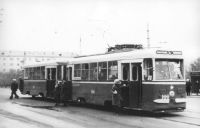

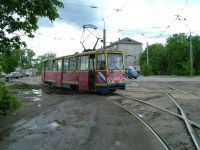
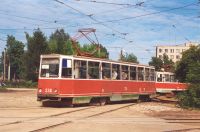
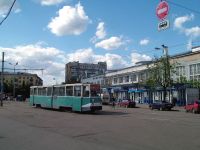
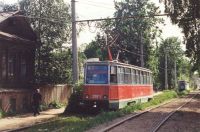
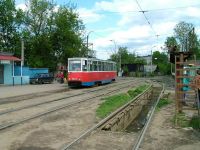
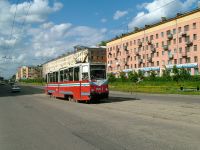
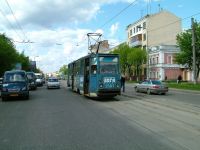
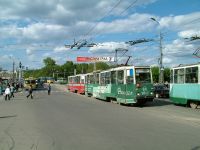
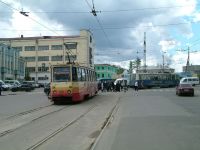
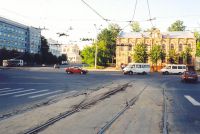

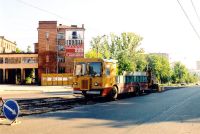
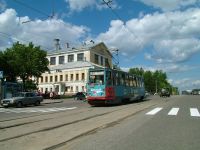
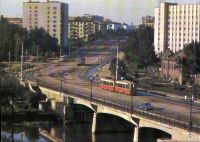

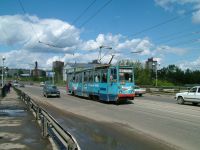
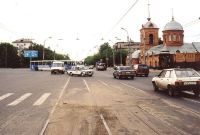
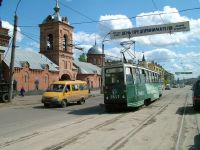
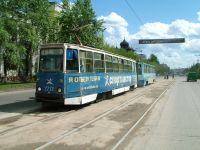
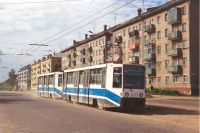
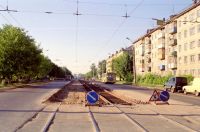
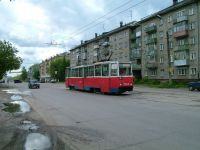
Here you will find a collection of pictures on Ivanovo.
Special thanks to Aare Olander and Vladimir Podkorytov for historic pictures provided, and especially to Michael Kolyadov for pictures and valuable information.
• A detailed description of the tram and trolleybus network
 |
01. This historic photograph shows the previously used in Ivanovo KTM/KTP-2 two-axle tram. In the KTM/KTP abbreviation, "M" stands for "motorniy" (motor), "P" for "pritsepnoy" (trailer). The location and date of this photo are under investigation. (Photo by Wolfgang Shreiner, provided by Aare Olander) |
 |
02. This single track loop behind The Main Railroad Station Terminal, is served by all city tram routes. It is a turnaround for routes #2 and 5. Routes #1, 3 and 6 also use this loop for through movements. Car 309-T is captured here during the short layover, which usually ends with the following car arriving behind. In most cases there is no layover at all, en-route layovers are preferred in Ivanovo, with dispatch stations located in the middle of the route. (27 May 2004) |
 |
03. The main workhorse of Ivanovo tramways, a standard KTM-5 car is making its way out of the only city tram Depot near the Main Railroad Station Terminal. This picture is taken at the same loop as above. (27 May 2004) |
 |
04. The loop is so small that it could only fit 4 cars at a time if put at close distance from one another. In this picture #238 is turning toward Prospekt Engelsa, the line that was closed between June of 1999 and July 22, 2002. This photo was made before the initial closure. (Aare Olander, 15 June 1994) |
 |
05. Car 274-T is pictured passing in front of the Ivanovo's unimpressive Main Railroad Station Building. This car was locally rebuilt. The road sign above prohibits buses near the building, yet trams are allowed to run through the square. (27 May 2004) |
 |
06. Stantsionnaya ul. is a tramway-only street used by trams to get from the Main Railroad Station Terminal to Prospekt Lenina, the main city thoroughfare. All city tram services use this street. Note the wooden structure on your left. (Aare Olander, 15 June 1994) |
 |
07. 10 years later the structure is burned down (see the same building in the background). The extra track is a layover area for the passing trams, as there is none available at the actual terminal 2 stops further up the line. The dispatch station is also located here, not at the terminal, thus some cars are delayed at this point with the passengers aboard, before making it to the end of the route. (27 May 2004) |
 |
08. Car 260-T is pictured speeding down the main section of Propekt Lenina, the main city thoroughfare, near Gromoboya Street. The absence of traffic here is not common these days, and is rather a result of a considerable wait for this picture-perfect opportunity. The color scheme applied to this car is a variation using the national colors of The Russian Federation. (27 May 2004) |
 |
09. Car 258-T poses for a stop on Prospekt Lenina near Demidova Street. The traffic law is rarely obeyed in modern Russia, tramway passengers are the direct victims of such indifference. All 3 minibuses in the picture are privately run and represent a direct competition to the trams in places, where road traffic is possible. (27 May 2004) |
 |
10. two car trains have disappeared from Ivanovo streets long time ago. Yet nowadays such sighting is not impossible, if there is a break down, which average visitor has good chances to observe. On 27 May 2004, there were two cases like that noted throughout the system. This picture is taken just off the bridge over the Uvod River near Pushkina Square. Prospekt Lenina is also served by trolleybus routes #2, 4, 7 and 8. Trolleybus wire to the left is leading toward the terminal at the square, used as turnaround for routes #1 and 10 and through runs by #5. (27 may 2004) |
 |
11. These two trams of the circular routes #1 and 6 do meet again in the city center, at Revolyutsii Square, at the beginning of Lenina Prospekt. During the time when the line via Engelsa Prospekt was closed from June 1999 to 22 July 2002, the loop around the city center was no longer possible, and the traditionally circular routes #1 and 6 were converted into one single route #1. (27 May 2004) |
 |
12. Ivanovo became famous in the tramway industry, as it is the only Russian city that closed an entire tramway line, partially dismounted it, but then reopened it again. This is the view at the beginning of the line at Revolyutsii Square during the closure. (11 June 2002) |
 |
13. The same spot as observed in 2004. The trams are running via Engelsa Prospekt again, however there was not enough money to rebuilt all the switches at Revolyutsii Square. The section of the track that existed before and allowed for a through movement from Lenina Prospekt to Engelsa Prospekt was not restored, as there was no need for it in regular service. Thus, the system did not regain the flexibility of the alternative routing within the city center that it ones enjoyed. (27 May 2004) |
 |
14. The pavement gets cracked open, and paved-over tracks begin to see daylight again. This restoration work onEngelsa Prospekt was observed in progress on Russia's Independence Day - a national holiday! The work vehicle is a KTG-10 disel-electric trolleybus, used in this capacity by many trolleybus undertakings throughout Russia. Note that trolley poles are placed on tram wire for two opposite directions, as wires are apparently re-powered for the completion of the project. The trolleybus is powering the other field work equipment behind it. (12 June 2002) |
 |
15. Car 311-T is speeding near the same spot as above, on Engelsa Prospekt near Pushkina Street. (27 May 2004) |
 |
16. This postcard depicts Prospekt Engelsa the way it was in the mid-1980s. Note a two-car set of KTM/KTP-2 on the bridge. (Postcard from mid-1980s, contributed by Vladimir Podkorytov) |
 |
17. This photo was made on the same bridge in July of 1992. The bridge goes over the Uvod River, and was the initial excuse for this tram line's closure, as it was reconstructed for a while. Trams however, did not come back here when work on the bridge was completed. Routes #1, 3 and 6 passed through here before the closure. The appearance of #2 is inconsistent, thus hinting that the alternative route, pr. Lenina was closed for tramway traffic at the time. Note single headlights on all cars, which was common back in then. Also note a two-car set of KTM-5s in the back. (Aare Olander, 1 July 1992) |
 |
18. The same bridge in 2004 sees less service, and no coupled trains at all. (27 may 2004) |
 |
19. Pr. Engelsa at Ul. Gromoboya. The way this line was kept during the 3 years of closure. A Turkish-built Mercedes articulated bus shown is taking over some passenger loads. (11 June 2002) |
 |
20. By 2004 the trams are back. Car 284-T is pictured here flying through the same intersection on relatively restored but still uneven track. The condition of the track does not slow this car down at all. (27 may 2004) |
 |
21. Another train consisting of rather peculiar arrangement of the two different car types KTM-5 + KTM-8 is observed on Engelsa Prospekt. Most of the newer but less reliable and promising KTM-8 cars were taken out of service, yet one car is still used to train student drivers. It is not clear why would the car of this unusual type with no future would be used for training purposes, not the regular equipment. On the day in question the lesson had to be cut short, as the service car in-front of the training car stalled, and the car behind was obliged to pull it to the depot. (27 May 2004) |
 |
22. A two-car set of KTM-8s cars is speeding along Prospekt Engelsa as it approaches the Main Railway Station Terminal, before the closure. (Aare Olander, 15 June 1994) |
 |
23. Exactly the same spot as in the previous photo the way it was found 8 years later in 2002. The new tracks are laid into Prospekt Engelsa in anticipation of the line's reopening. (12 June 2002) |
 |
24. The same spot in 2004: the service is back to normal. (27 May 2004) |